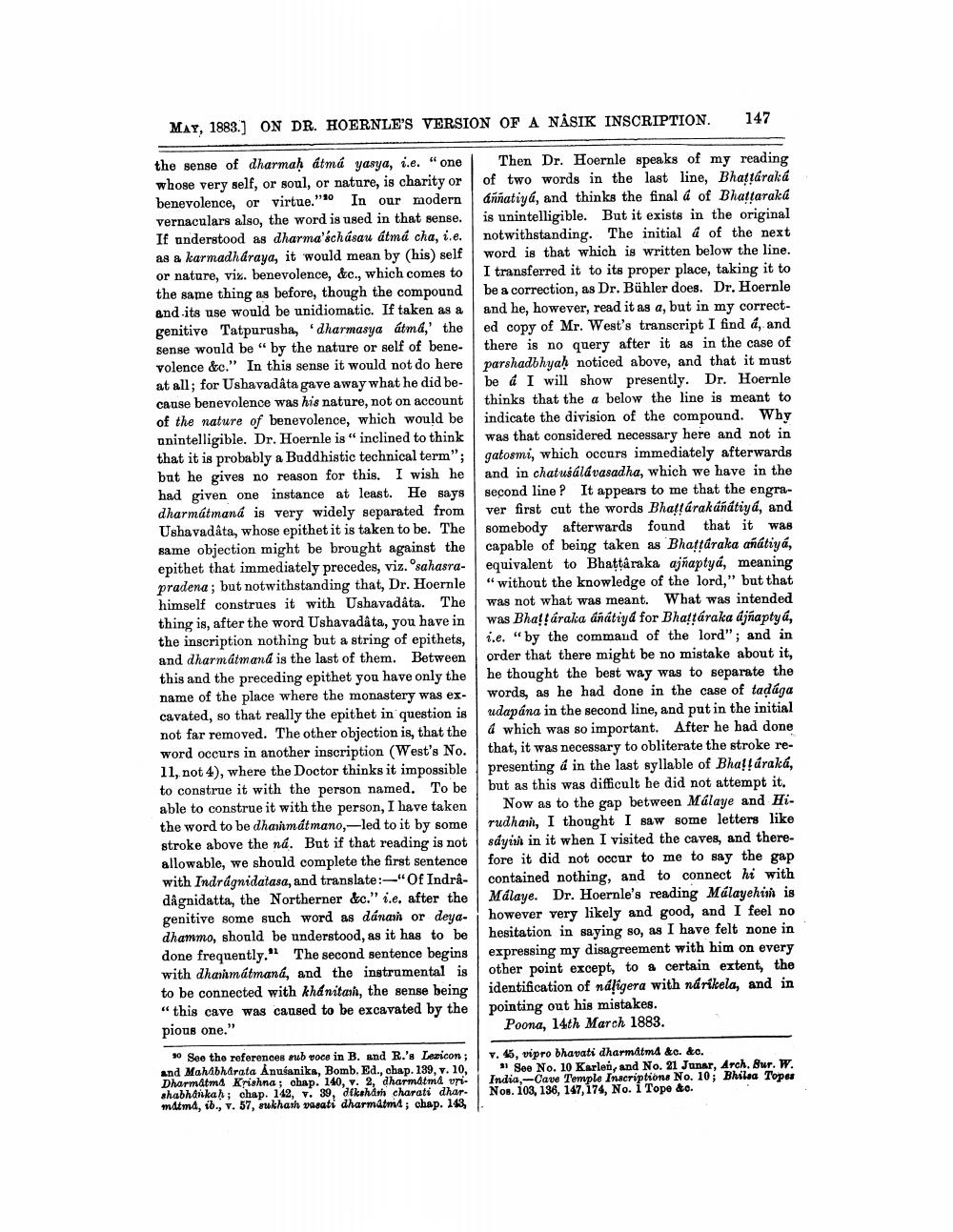________________
MAY, 1883.) ON DR. HOERNLE'S VERSION OF A NÁSIK INSCRIPTION.
147
the sense of dharmaḥ átmá yasya, i.e. "one! Then Dr. Hoernle speaks of my reading whose very self, or soul, or nature, is charity or of two words in the last line, Bhattáraká benevolence, or virtue." 30 In our modern aññatiya, and thinks the final d of Bhattaraka vernaculars also, the word is used in that sense. is unintelligible. But it exists in the original If understood as dharma'échásau átmá cha, ie. notwithstanding. The initial á of the next as a karmadhdraya, it would mean by (his) self word is that which is written below the line. or nature, vix. benevolence, &c., which comes to I transferred it to its proper place, taking it to the same thing as before, though the compound be a correction, as Dr. Bühler does. Dr. Hoernle and its use would be unidiomatic. If taken as a and he, however, read it as a, but in my correctgenitive Tatpurusha, dharmasya átmá,' the ed copy of Mr. West's transcript I find á, and sense would be " by the nature or self of bene. there is no query after it as in the case of volence &c." In this sense it would not do here parshadbhyah noticed above, and that it must at all; for Ushavadâta gave away what he did be- be d I will show presently. Dr. Hoernle cause benevolence was his nature, not on account thinks that the a below the line is meant to of the nature of benevolence, which would be indicate the division of the compound. Why unintelligible. Dr. Hoernle is" inclined to think was that considered necessary here and not in that it is probably a Buddhistic technical term"; | gatosmi, which occurs immediately afterwards but he gives no reason for this. I wish he and in chatusáldvasadha, which we have in the had given one instance at least. He says second line? It appears to me that the engradharmátmaná is very widely separated from ver first cut the words Bhattárakánátiya, and Ushavadåta, whose epithet it is taken to be. The somebody afterwards found that it was same objection might be brought against the capable of being taken as Bhattáraka añátiya, epithet that immediately precedes, viz.osahasra- equivalent to Bhattaraka ajñaptyd, meaning pradena; but notwithstanding that, Dr. Hoernle "without the knowledge of the lord," but that himself construes it with Ushavadata. The was not what was meant. What was intended thing is, after the word Ushavadâta, you have in was Bhattáraka áñátiyd for Bhattáraka djñaptyú, the inscription nothing but a string of epithets, i.e. "by the command of the lord"; and in and dharmátmand is the last of them. Between order that there might be no mistake about it, this and the preceding epithet you have only the he thought the best way was to separate the name of the place where the monastery was ex- words, as he had done in the case of tasága cavated, so that really the epithet in question is udapána in the second line, and put in the initial not far removed. The other objection is that the which was so important. After he had done word occurs in another inscription (West's No.
that, it was necessary to obliterate the stroke re11, not 4), where the Doctor thinks it impossible presenting & in the last syllable of Bhalfáraká, to construe it with the person named. To be but as this was difficult he did not attempt it. able to construe it with the person, I have taken Now as to the gap between Málaye and Hithe word to be dharnmátmano,-led to it by some rudhari, I thought I saw some letters like stroke above the na. But if that reading is not sdyirh in it when I visited the caves, and thereallowable, we should complete the first sentence fore it did not occar to me to say the gap with Indragnidatasa, and translate :-"Of Indra- contained nothing, and to connect hi with dâgnidatta, the Northerner &c." i.e. after the Mdlaye. Dr. Hoernle's reading Málayehin is genitive some such word as dánan or deya- however very likely and good, and I feel no dhammo, should be understood, as it has to be hesitation in saying so, as I have felt none in done frequently." The second sentence begins expressing my disagreement with him on every with dhanmátmana, and the instrumental is other point except, to a certain extent, the to be connected with khanitari, the sense being identification of ndļigera with ndrikela, and in “this cave was caused to be excavated by the pointing out his mistakes. pious one."
Poona, 14th March 1883.
90 See the references sub voce in B. and R.'s Lexicon v. 45, vipro bhavati dharmatma &c. &c. and Mahabharata Anusaniks, Bomb. Ed., chap. 139, v. 10,! See No. 10 Karlen, and No. 21 Janar, Arch. Sur. W. Dharmátmd Krishna; chap. 140, v. 2, dharmatma uri India, -Cave Temple Inscriptions No. 10; Bhilsa Topa shabhän kah; chap. 142, v. 39, dikahan charati dhar. Nos. 103, 136, 147, 174, No. 1 Tope &c. mdemd, ib., v. 57, sukhath vusati dharmdemd, chap. 113, 1.




